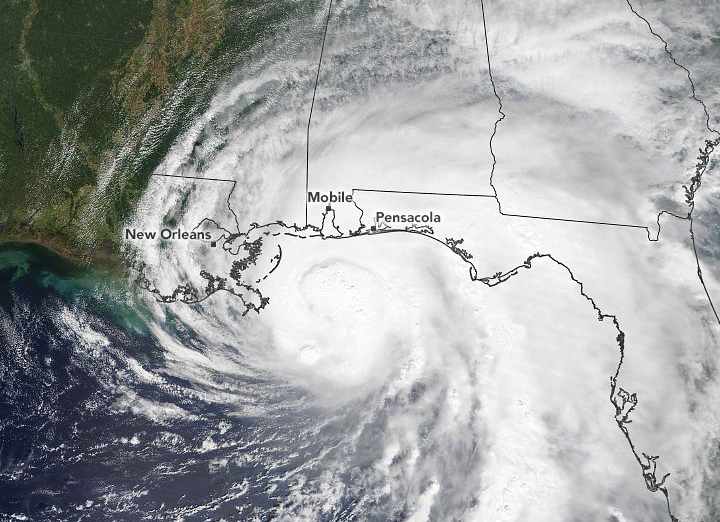In what may be taken as a positive sign of what’s to come for the insurance, reinsurance and insurance-linked securities (ILS) community, two of the main Atlantic hurricane forecast teams have reduced their seasonal forecast numbers.
 But their landfall predictions are still elevated, meaning the chances of a damaging season remain.
But their landfall predictions are still elevated, meaning the chances of a damaging season remain.
The Colorado State University tropical forecasting team still expect an above-average level of activity during the 2021 Atlantic hurricane season, while the Tropical Storm Risk team is now calling for something closer to normal.
The reasons for the reductions appear to be largely due to time having passed since the last, while conditions appear roughly the same in the Atlantic.
Both of the forecast teams had increased their forecast numbers in July, largely to factor in the activity already seen in the Atlantic hurricane basin.
But now that we’ve had a quieter period, both teams have dropped their forecasts for named tropical storms and hurricanes back down again.
While we say this could be seen as a positive sign, of course seasonal hurricane forecasts are really only directional at best, giving those in insurance, reinsurance catastrophe bonds and insurance-linked securities (ILS) an idea of what may come over the course of the hurricane season.
In reality, what matters is the direction of travel for any named storms that form, whether they get the chance to intensify and make landfall in highly urbanised and populated regions, where industry losses are likely to be more significant and potentially impact reinsurance and ILS positions.
At the last forecast update in early July, the tropical storm and hurricane research meteorologists at Colorado State University increased their forecast for activity during the 2021 Atlantic hurricane season to include 20 named storms, 9 hurricanes and 4 major hurricanes, with accumulated cyclone energy (ACE) of 160.
Now, their August update lowers these figures, to 18 named storms, 8 hurricanes and 4 major hurricanes, with accumulated cyclone energy (ACE) of 150.
This forecast team said, “We have decreased our forecast slightly but continue to call for an above-average 2021 Atlantic hurricane season. Sea surface temperatures averaged across the tropical Atlantic are now warmer than normal, while vertical wind shear anomalies averaged over the past 30 days over the Caribbean and tropical Atlantic are slightly weaker than normal. Current cool neutral ENSO conditions are likely to persist (and perhaps even transition to weak La Niña conditions) by the peak of the Atlantic hurricane season.
“We continue to anticipate an above-normal probability for major hurricanes making landfall along the continental United States coastline and in the Caribbean.”
Meanwhile, the Tropical Storm Risk forecasting team had also increased its forecast in July, to 20 named tropical storms, 9 hurricanes and 4 major hurricanes, with ACE of 141.
Now, at their August update, the Tropical Storm Risk (TSR) forecasting team has lowered this back down to 18 named tropical storms, 7 hurricanes and 3 major hurricanes, with ACE of 122.
The reductions made by the TSR forecasting team are more significant and bring the forecast closer to the near-term normal, just one named storm above the average of the last decade.
The TSR forecast team explained, “TSR has lowered its outlook for basin tropical cyclone activity because the July 2021 Atlantic meridional mode, the July Atlantic multidecadal oscillation and, crucially, the July trade winds and sea surface temperatures over the tropical North Atlantic and Caribbean Sea all point to hurricane activity that will be close to the 10-year norm rather than to well-above norm.”
However, like the Colorado State team, TSR is also warning of continued above-average landfalling probabilities for the United States coastline, which is clearly a factor of note for reinsurance, cat bond and ILS interests.
“In contrast, US landfalling activity is forecast to be slightly more above-norm than thought previously due to July 2021 steering winds over the North Atlantic being favourable for US storm landfalls and to the expectation that a weak La Niña will develop during autumn 2021 which would favour storm formations closer to the US (and thus favour more landfalls),” the TSR forecasters explained.
Steering currents are critical as the season progresses, as this is what can set long-tracked hurricanes on a course for the United States, taking them over warm seas to generate energy and strengthen.
So, while the headline numbers are down, they remain high enough for a very impactful hurricane season, should the storms form in the right locations and be steered landwards.
Adding these latest updates to the set of forecast data-points tracked by the reinsurance, catastrophe bond and wider ILS industry, our Artemis average now sits at 17 named storms (down by 1 with these additions), 8 hurricanes (down by 1) and 4 major hurricanes, with ACE of 140.
Track the 2021 Atlantic tropical storm and hurricane season on our dedicated page and we’ll update you as new forecasts and information emerges.
 View all of our Artemis Live video interviews and subscribe to our podcast.
View all of our Artemis Live video interviews and subscribe to our podcast.
All of our Artemis Live insurance-linked securities (ILS), catastrophe bonds and reinsurance video content and video interviews can be accessed online.
Our Artemis Live podcast can be subscribed to using the typical podcast services providers, including Apple, Google, Spotify and more.































